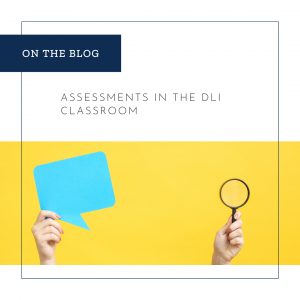
“I don’t teach my kindergarten students in English at all, but the district administration is saying I have to test them in English foundational skills.”
“Our first graders are visibly confused and upset when they’re faced with computerized math and reading assessments in English. We’ve never taught them math in English, nor have we taught them English reading. It’s not how our DLI program model works.”
If you’ve found yourself nodding your head as you read those quotes because you’ve been saying or hearing something similar in your own context, you wouldn’t be alone. It’s far too common that “what’s done in English” programming models is automatically applied to the dual language immersion programs that neighbor them. What we’ve found over the years, however, is that when schools engage their dual language immersion students in assessment practices that match their DLI model’s construct, students win — in BOTH languages, even when they’re primarily assessed in the minority language.
Any and all dialogue that we have with schools about assessment centers around these three key statements and their descriptions:
- Assessments must be in the language of instruction.
It makes absolutely ZERO sense to test children in a language in which they have not been formally taught. For example, if your kindergarten and first grade DLI classrooms serve students ONLY in Spanish for their core content areas, don’t assess them in English! Instead, assess in the language of instruction so that continuity among instruction, learning, and assessment. If your program teaches a 90/10 model, don’t let yourself think that the “10% means it’s okay to test in English.” Most high-quality 90/10 programs focus on all initial literacy in the minority language — NOT English. Keep formally assessing in the minority language while you use that 10% to build oracy in English in the early grades. The English performance will come. Just not now because it’s not how the program’s designed.
- Formative, classroom-based observation tools put Language First.
We say it all the time that language targets and linguistic foci aren’t “more on the plate.” They ARE the plate. Just think about it. If students possess the language they need to handle the content, they’re that much better equipped to successfully handle new learning! If we put Language First during core content area instruction, we must ensure that Language First lives and breathes in the assessments we provide at the classroom level!
In our addalingua professional learning courses, we train teachers on how to use linguistic “look fors” tied to weekly language targets on formative, classroom-based assessments. We do this through the creation of observation and conferring checklists and through student-based linguistic reflection check-ins. The big idea here is that, if we’re using a rubric to assess the content of a project, said rubric should ALSO prioritize the linguistic forms/features that are needed to accurately demonstrate knowledge and skills.
- The best assessments for DLI students access their performance across three modes of communication.
Integrated Performance Assessments (IPAs) are high-powered, project-based assessment experiences that invite students to engage with the content AND the language across three modes of communication: interpretive, interpersonal, and presentational. This invitation to the three modes inspires students to dive into the deep end of their learning as they process ideas through reading or listening, spontaneously exchange ideas through dialogue, and present ideas in well-prepared verbal or written forms. This type of assessment provides a robust view of students’ depth of understanding and linguistic capabilities! Throughout addalingua’s Language First certification, we introduce participants to the three modes of communication, and to the design of activities that encourage students to fully express themselves across all three. Join us to start exploring!
In reading that, we know what you’re thinking: “But, WHAT ABOUT ENGLISH?! DON’T THE STUDENTS HAVE TO ALSO LEARN ENGLISH AND SHOW THAT THROUGH TESTING?!” Sure. It goes without saying that we want students to perform well on English measures of academics once they enter the picture at appropriate junctures in the DLI program model. And still, we know based on experience that English language assessment performance doesn’t have to come at the expense of high-quality teaching, learning, and assessment in the minority language of the DLI program.
If you have questions, comments, or want to talk about assessing in the language of instruction in your DLI program, reach out, we would love to hear from you! Also, hear more at our Language First conference for DLI educators in April 2024, register here today!


